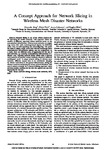A Concept Approach for Network Slicing in Wireless Mesh Disaster Networks
| dc.contributor.author | Seng, A | |
| dc.contributor.author | Trick, U | |
| dc.contributor.author | Lehmann, A | |
| dc.contributor.author | Ghita, B | |
| dc.date.accessioned | 2022-11-07T11:37:06Z | |
| dc.date.available | 2022-11-07T11:37:06Z | |
| dc.date.issued | 2022-01-01 | |
| dc.identifier.isbn | 9783800758739 | |
| dc.identifier.uri | http://hdl.handle.net/10026.1/19866 | |
| dc.description.abstract |
Network Slicing is one of the critical enablers for the upcoming 5G mobile networks. This approach allows the creation of different, separated virtual networks based on the same physical infrastructure. Wireless mesh networks can supply large areas with radio technology-based signals via individual nodes. They are self-organising and self-configuring. This qualifies them to supply larger areas with wireless technology-based communication infrastructure quickly and less complicated. As a result, there are different areas of application for the use of such networks, e.g. restoring communication infrastructure in a disaster area. Applying network slicing within such a wireless mesh network can provide virtual networks adapted to different participants’ needs. To adapt network slicing on wireless mesh networks, different aspects have to be considered: Mapping the virtual connections to the pysical infrastructure, slicing the wireless resources and placing the virtual network functions. This work is about a concept for a Network Slicing approach which provides possible solutions for the first two aspects and and first approaches for the last. | |
| dc.format.extent | 46-51 | |
| dc.language.iso | en | |
| dc.title | A Concept Approach for Network Slicing in Wireless Mesh Disaster Networks | |
| dc.type | conference | |
| dc.type | Conference Proceeding | |
| plymouth.publication-status | Published | |
| plymouth.journal | Mobilkommunikation: Technologien und Anwendungen - 26. ITG-Fachtagung | |
| plymouth.organisational-group | /Plymouth | |
| plymouth.organisational-group | /Plymouth/Faculty of Science and Engineering | |
| plymouth.organisational-group | /Plymouth/Faculty of Science and Engineering/School of Engineering, Computing and Mathematics | |
| plymouth.organisational-group | /Plymouth/REF 2021 Researchers by UoA | |
| plymouth.organisational-group | /Plymouth/REF 2021 Researchers by UoA/UoA11 Computer Science and Informatics | |
| plymouth.organisational-group | /Plymouth/Users by role | |
| plymouth.organisational-group | /Plymouth/Users by role/Academics | |
| dc.rights.embargoperiod | Not known | |
| rioxxterms.licenseref.uri | http://www.rioxx.net/licenses/all-rights-reserved | |
| rioxxterms.type | Conference Paper/Proceeding/Abstract |


